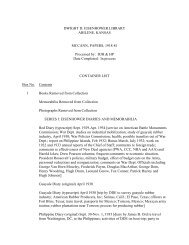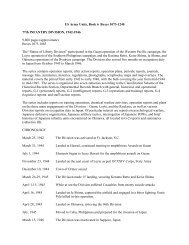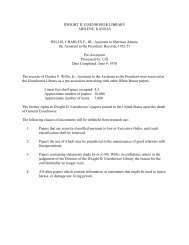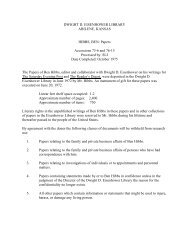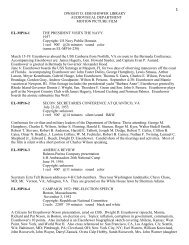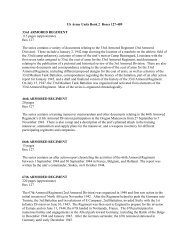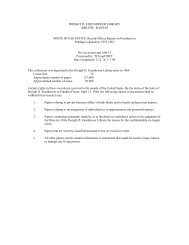supreme headquarters, allied expeditionary force - Dwight D ...
supreme headquarters, allied expeditionary force - Dwight D ...
supreme headquarters, allied expeditionary force - Dwight D ...
Create successful ePaper yourself
Turn your PDF publications into a flip-book with our unique Google optimized e-Paper software.
SCOPE AND CONTENT NOTEThe records described below, received from Modern Military Records Division in the NationalArchives, are duplicates of records created within the various components of SupremeHeadquarters Allied Expeditionary Force. The records, though coming to the Library in separateshipments, have been combined with records of similar origin to comprise this accession. Typesof records include: G-2 Digests (intelligence notes issued weekly giving German troopmovements and intelligence re German troops in Germany) June 7, 1944-May 12, 1945; G-2War Diaries (reports on, and plans for intelligence operations) December, 1943-January, 1944;G-2 Weekly Intelligence Summaries (summaries of intelligence) April 1, 1944-May 6, 1945; G-2 Intelligence Notes (notes on enemy troop movements, weapons and equipment) June 29, 1944-May 12, 1945; G-2 FATHERLAND (reports presenting matters of primary interest for the periodof occupation of Germany) October 19, 1944-May 17, 1945 (not inclusive); G-2 SCAVENGER(reports, similar in content to FATHERLAND, and also their successor) May 14, 1945-June 24,1945; G-2 Reports (chronicle Allied air, ground, and sea actions and enemy troop locations,movements and actions primarily in the ETO and Russia, but also, periodically, in the Far East)July 4, 1944-June 6, 1945 (not inclusive); G-2 Ground Checking Notes (compilations ofphotographs of newly captured German defenses in Western Europe, the purpose of which wasto assist interpreters in the identification of enemy installations on subsequent air missions)November, 1944-January, 1945; G-2 Neptune-Argus (daily issuance of current intelligence reenemy defenses and topography for Operation Neptune) April 28, 1944-May 19, 1944, notinclusive; Miscellaneous G-2 (Counter Intelligence Division) reports re German booby traps,tanks, intelligence services, labor, concentration camps, police (and KRIPO officials), the SA,and the Hitler Youth; G-3 War Room Daily Summaries (reports of Allied air, ground and navaloperations and order of battle for Allied troops in the ETO) June 6, 1944-July 12, 1945; G-3 WarDiaries (compilation of cables, letters, maps, memos, plans for Operation Eclipse, handbook,minutes of meetings and plans and progress reports for Allied Operations) November, 1944 -April, 1945; 12th Army Group weekly intelligence summaries; 21 Army Group operationalplans; Allied Naval Commander-in-Chief Expeditionary Force war diaries and reports;memoranda re Operations Neptune and Eclipse; and miscellaneous reports of IX Troop CarrierCommand and 1st Allied Airborne Army Operations in Northwest Europe.The term European Theater of Operations came to be used during the war to designate the areaof Operations of the United States air, ground, naval and supply <strong>force</strong>s that joined the British<strong>force</strong>s after December 7, 1941. The Theater area eventually stretched from the British Isles toEastern Germany and from the Scandinavian countries south to the Pyrenees, the Mediterranean,the northern border of Italy, and the Balkans. On June 8, 1942, the European Theater ofOperations United States Army (ETOUSA) replaced a command, termed the United States ArmyForces in the British Isles, which had been formed in January 1942 to combine planning, supply,and tactical activities of American groups in the British Isles.Until June 6, 1944, ETOUSA was concerned primarily with building up ground and supporting<strong>force</strong>s for the invasion across the English Channel.




